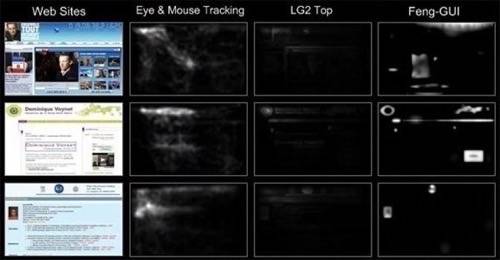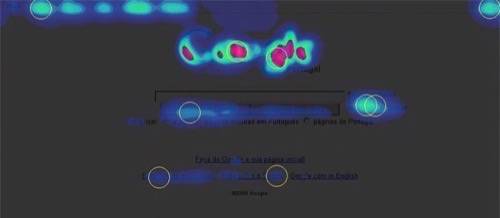Feng-GUI is an interesting heatmap creation service. Unlike click-based heatmaps from Crazy Egg, FuseStats, and others, Feng-GUI creates heatmaps based on where it thinks the human eye would most likely be attracted. Eye tracking is something that designers have long used to measure the effectiveness of advertising, or design more usable web sites (among other commercial applications). But Feng-GUI doesn’t use real eye tracking, which would require that humans look at each object being measured and would hardly scale very well. Instead, the site uses an algorithm that attempts to guess what a real human would be most likely to look at.

According to Feng-GUI, their ViewFinder algorithm is based on research from the field of robotics into how humans see and what sort of physiologic and neurological processes go on in our brains when we look at things. The algorithm than creates a saliency map. Saliency is a neuroscience term that describes how much an object stands out relative to its neighbors.
Feng-GUI has been around for awhile — it was pitched on the TechCrunch forums to little reaction over a year ago — but just recently the company released the results of a test that it says proves the accuracy of its algorithm. According to the company, Feng-GUI attention maps capture 70% of what traditional eye and mouse tracking report — or, in other words, they are 70% as accurate. Because the work is being done by a computer rather than humans, one has to assume that it is cheaper.

The visual results of the test are impressive — Feng-GUI does indeed seem to stack up well to traditional eye tracking. But because the methodology of the study, who did it, and how it was conducted wasn’t released, it is hard to trust it.
There is, however, one major problem with Feng-GUI: I couldn’t get it to work. The heat map generator on the Feng-GUI page timed out on every attempt to generate a map for ReadWriteWeb (it supposedly times out after 30 seconds, but RWW has loaded quickly all day), or any other web site I tried. Nor could I get it generate a map for a screenshot of ReadWriteWeb that I uploaded.
Google’s Portuguese site as seen by Feng-GUI.

Regardless, I do like the idea of Feng-GUI. If the algorithm can be trusted, it has a lot of useful applications for designers and web site owners. The service could theoretically be used for testing early stage prototypes of new designs without having to pay people to perform usability studies or exposing half-baked new ideas to beta testers. Or it could be used by advertisers to figure out which display ad would attract the most attention on a specific web site before making an ad buy. Theoretically, sites could even use data from the service to charge more for a specific ad spot based on visual attention rather than higher click-thru rates (though selling advertisers on a robot’s opinion might be a bit of a tall order).
What do you think of the idea of eye tracking vs. click tracking? What about algorithmic pseudo-eye tracking? Could you get Feng-GUI to work for you? Leave your thoughts in the comments below.





















